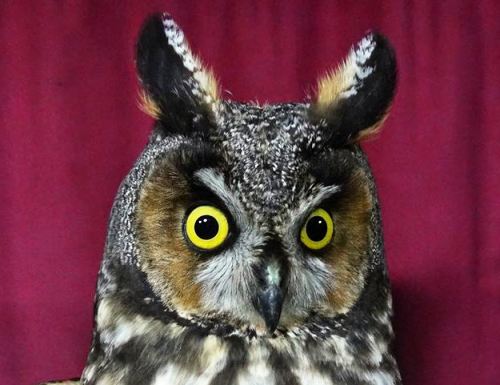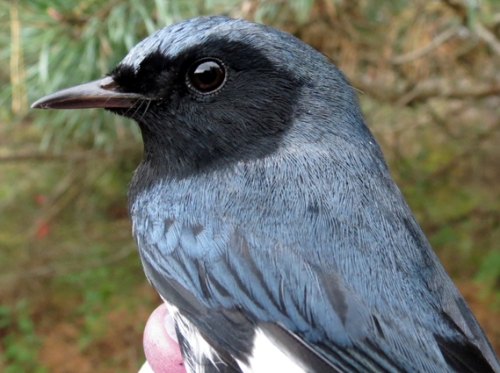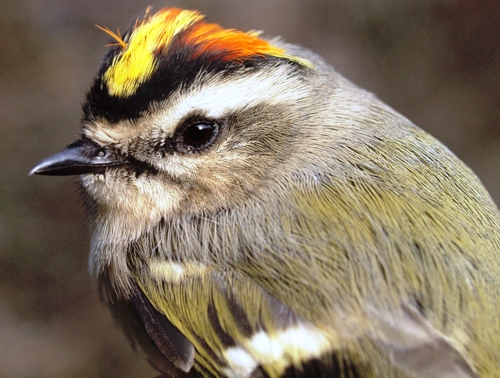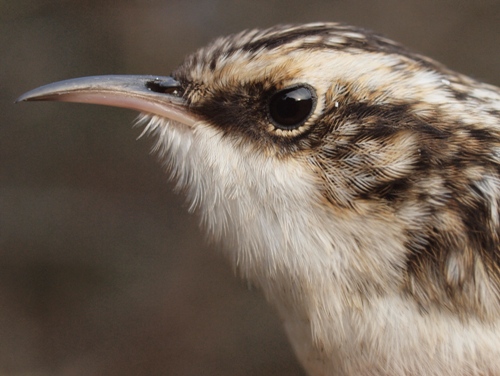|
Week 12: October 17 - 23, 2013 |
Welcome
to the McGill Bird Observatory weekly report.
Click here for a complete listing of our archives.
Comments or
questions are welcome at "mbo AT migrationresearch.org".
|
PICTURE
OF THE WEEK: |
|

The first Long-eared Owl banded at MBO this fall, and just the third ever.
(Photo by Nicolas Bernier)
-
|
|
|
THIS WEEK |
THIS FALL |
2013 TOTAL |
SITE TOTAL |
|
# birds (and species) banded |
170 (21) |
3207 (76) |
4502 (87) |
46014 (113) |
|
# birds (and species) repeat |
25 (7) |
729 (45) |
1059 (56) |
9040 (70) |
|
# birds (and species) return |
4 (3) |
50 (18) |
205 (35) |
1414 (38) |
|
# species observed |
60 |
144 |
166 |
209 |
|
# net hours |
335.0 |
6060.0 |
9416.8 |
78706.5 |
|
# birds banded / 100 net hours |
50.7 |
52.9 |
47.8 |
58.4 |
|
|
Note: table does not include nocturnal banding (owls) |
|
Banders-in-charge: Simon Duval, Gay Gruner
Assistants: Nicolas Bernier, Marc Boisvert, Cindy Bouchard, Marie-France Boudreault, David Davey, Geneviève Dubois, Réjean Duval, Jo-Annie Gagnon, Nathalie Gendron, Alison Hackney, Lisa Keelty, Betsy McFarlane, Marie Perkins, Catherine Russell, Marilou Skelling, Rodger Titman, Jay VanderGaast, Corrine Waheed
Notes: Banding numbers continued to decline this week, although in part that was the result of a spell of rough weather, with two days lost to rain, and effort restricted by weather on another three mornings. Despite that, the number of species observed was again well above average for the period, as has been the case for most of this fall.

By mid-October, warblers at MBO are largely limited to Yellow-rumped, but the occasoinal late Black-throated Blue can be found too.
(Photo by Gay Gruner)
|
Although present throughout the season, Red-winged Blackbirds usually stay high above the nets this fall, so the one banded this week was our first of the season. The only new species observed for the season was Rough-legged Hawk on the last day of the week.
This week’s top 10 [last week's rank in brackets]
# individuals banded |
mean # individuals observed daily |
1. American Robin (68) [3] |
1. American Robin (392) [2] |
2. Ruby-crowned Kinglet (28) [1] |
2. Red-winged Blackbird (326) [3] |
3. White-throated Sparrow (15) [1] |
3. European Starling (251) [4] |
4. Golden-crowned Kinglet (12) [4] |
4. Canada Goose (170) [1] |
5. Hermit Thrush (11) [9] |
5. Common Grackle (63) [6] |
6. Common Grackle (8) [-] |
6. American Crow (53) [5] |
7. Slate-colored Junco (6) [5] |
7. Ring-billed Gull (28) [8] |
8. Yellow-rumped Warbler (3) [6] |
8. White-throated Sparrow (18) [7] |
8. American Tree Sparrow (3) [-] |
9. Black-capped Chickadee (16) [-] |
8. Song Sparrow (3) [7]
|
10. Ruby-crowned Kinglet (16) [10]
|
|
The second half of October is traditionally robin season at MBO, and this week exemplified that. We banded more than twice as many American Robins this week as any other species, marking the fifth time in nine years that they have dominated the list of species banded in week 12. The number of Ruby-crowned Kinglets banded in week 12 has ranged from 5 to 73 over the years, and the count of 28 this week was close to average. White-throated Sparrow also dropped from top spot last week, with the 15 banded a bit below the long-term average of 20 for week 12. Meanwhile, Golden-crowned Kinglets continued to be banded in above-average numbers, reaching a new record high for a season. Hermit Thrushes rebounded a bit this week, while part of a grackle flock got into the nets, with this week's 8 individuals banded more than doubling the season total. Juncos are usually dominant by this late in the season, with between 15 and 134 banded in week 12 in past years, and a mean of 55 - so it was remarkable that only one-tenth as many were banded this week. Rounding out this week's top ten were a few lingering Yellow-rumped Warblers and Song Sparrows, and a handful of American Tree Sparrows.
Like in 2006 and 2010, American Robins were also the most abundant species observed at MBO in week 12 this year, with a mean daily count of nearly 400 individuals. The late-fall blackbird flocks continue to grow, with Red-winged Blackbird, Common Grackle, and European Staling all in the top five this week. Also in the top five was Canada Goose, which has been the most abundant species fo week 12 five times in the pevious eight years. The mean daily count of 170 was the lowest for week 12 since 2009, when it was 166. American Crow was in sixth place, but in surprisingly low numbers. The local flock usually grows toward the end of fall at MBO; this marks the first time in nine years of our Fall Migration Monitoring Program that the mean daily count of American Crow has been below 100 in week 12. On the other hand, Ring-billed Gull is not usually numerous at this time of year, but flocks passing overhead put it in the top ten for a second week in a row. Rounding out the top ten, White-throated Sparrows and Ruby-crowned Kinglets remained fairly common for most of the week, and with the overall number of migrants dropping, our resident flock of Black-capped Chickadees was numerous enough to get back on the list.

This is the first Eastern Screech-Owl we have recaptured at MBO - we banded it as a hatch-year individual last fall.
(Photo by Nicolas Bernier)
|
Our fourth week of owling this fall began slowly, with a lone Northern Saw-whet Owl and one Eastern Screech-Owl on October 17, followed by two nights lost to bad weather. As is often the case following the passage of such a weather system, the next night was productive as the owls were ready to be on the move again - we had our fourth best night of the season with 14 Northern Saw-whet Owls, plus our first Long-eared Owl of the season. Another 15 saw-whets over the final three nights of the week raised the season total to 130 banded. We also had yet another two foreign recaptures this week, including one banded at Little Gap, Pennsylvania in November 2010.
|

Golden-crowned Kinglets have been more numerous at MBO this fall than ever before, with over 100 banded so far.
(Photo by Simon Duval)

Brown Creepers and Golden-crowned Kinglets often favour similar habitat, so it seems appropriate to post their photos together too!
(Photo by Simon Duval)
|





